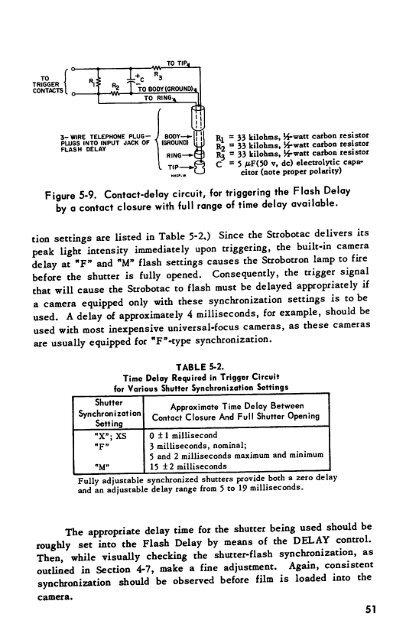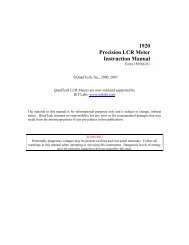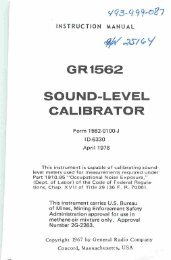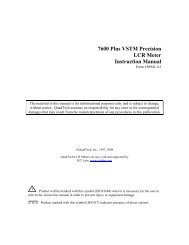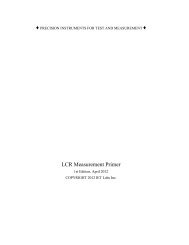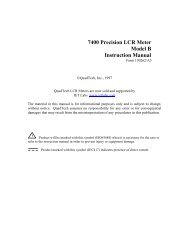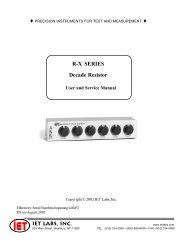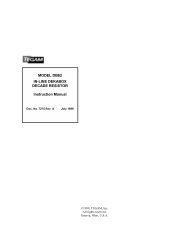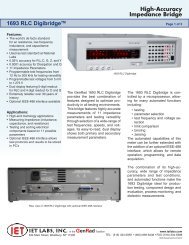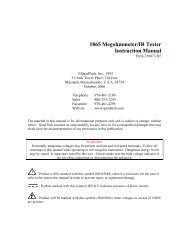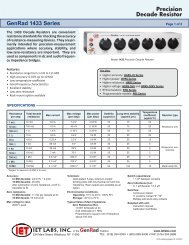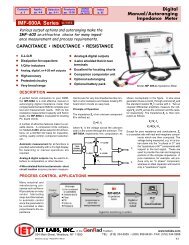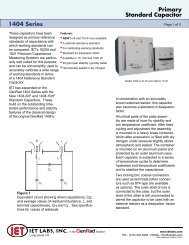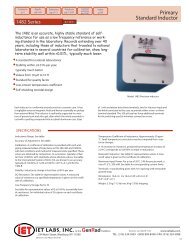Handbook of High Speed Photography - IET Labs, Inc.
Handbook of High Speed Photography - IET Labs, Inc.
Handbook of High Speed Photography - IET Labs, Inc.
You also want an ePaper? Increase the reach of your titles
YUMPU automatically turns print PDFs into web optimized ePapers that Google loves.
-1 vw T0TIP"<br />
TO f<br />
I+C "3<br />
TRIGGER 1<br />
CONTACTS [ | TO BODY (GROUND)^<br />
-vw-<br />
TO RING,<br />
3-WIRE TELEPHONE PLUG- J BODY—-<br />
PLUGS INTO INPUT JACK OF \ (GROUND)<br />
FLASH DELAY<br />
RING-<br />
(<br />
I TIP-<br />
Ri = 33 kilohms, H-watt carbonresistor<br />
R? = 33kilohms, J^-watt carbon resistor<br />
Ra = 33 kilohms, }4-watt carbonresistor<br />
C = 5 MF(50 v, dc) electrolytic capa<br />
citor (note proper polarity)<br />
Figure 5-9. Contact-delay circuit, for triggering the Flash Delay<br />
by acontact closure with full range <strong>of</strong> time delay available.<br />
tion settings are listed in Table 5-2,) Since the Strobotac delivers its<br />
peak light intensity immediately upon triggering, the built-in camera<br />
delay at "F" and WM" flash settings causes the Strobotron lamp to fire<br />
before the shutter is fully opened. Consequently, the trigger signal<br />
that will cause the Strobotac to flash must be delayed appropriately if<br />
a camera equipped only with these synchronization settings is to be<br />
used. Adelay <strong>of</strong> approximately 4 milliseconds, for example, should be<br />
used with most inexpensive universal-focus cameras, as these cameras<br />
are usually equipped for wF"-type synchronization.<br />
Shutter<br />
Synchronization<br />
Setting<br />
"X"; XS<br />
"M"<br />
TABLE 5-2.<br />
Time Delay Required in Trigger Circuit<br />
for Various Shutter Synchronization Settings<br />
Approximate Time Delay Between<br />
Contact Closure And Full Shutter Opening<br />
0+1 millisecond<br />
3 milliseconds, nominal;<br />
5 and 2 milliseconds maximum and minimum<br />
15 ±2 milliseconds<br />
Fully adjustable synchronized shutters provide both a zero delay<br />
and an adjustable delay range from 5 to 19 milliseconds.<br />
The appropriate delay time for the shutter being used should be<br />
roughly set into the Flash Delay by means <strong>of</strong> the DELAY control.<br />
Then, while visually checking the shutter-flash synchronization, as<br />
outlined in Section 4-7, make a fine adjustment. Again, consistent<br />
synchronization should be observed before film is loaded into the<br />
camera.<br />
51


